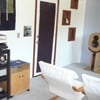-
Posts
6937 -
Joined
-
Last visited
Retained
-
Member Title
Senior Member
Personal Information
-
Location
Land of the Angles
Recent Profile Visitors
12235 profile views
-
There’s a cancellation dip to the sides of the speaker centred around 450Hz so that significant amount is unlikely. It’s certainly not visible in JA’s in-room response plot posted earlier.
-
The change in directivity knee seems to be at around 200Hz 45°,60°&75° https://www.soundstagenetwork.com/index.php?option=com_content&view=article&id=1540:nrc-measurements-kef-blade-two-loudspeakers&catid=77:loudspeaker-measurements&Itemid=153
-
Maybe you can ask Jack Oclee-Brown at A S R.
-
Below 80Hz the speaker acts roughly as an omni sound source, that includes ports and side woofers. Above 80Hz the port output has dropped significantly (and they can be plugged). You do have the back-to-back woofers operating as omnis for most of their operating range, which goes up to 300Hz. I think that the principle still applies but happy to be corrected. https://www.stereophile.com/content/kef-blade-two-meta-loudspeaker-measurements
-
You can't really assess sound quality at hi-fi shows. The best thing to do is to choose a couple of dealers who stock speakers from your shortlist and arrange a few demos, preferably at home if possible.
-
I understand the part about your friends preferring Klipschs but not the first sentence.
-
Are you using EQ? I have the back of my Reference 3s some 200mm from the wall and added a low-shelf compensation filter. That way I have managed to avoid a broadish cancellation dip centred at around 125 Hz. This diagram by Neumann indicates that the worst position for the woofer is distanced between 0.80m and 2.00m (bottom left table) from the front wall (it also shows the advantage of using subwoofers in minimising SBIR effects):
-
Sorry, I don't understand your post.
-
As you can see in the in-room response plot above the Blade 2 produces hardly any treble roll-off in the room. But the treble is effortless and there isn't the off axis flare in the presence region typical of many speakers. I suspect that the Blade 2s sound dull to some people because of the sound (deviations) that they're used to hearing, and perhaps enjoy. The Reference and R series do sound a bit dark/dull, perhaps more than that if people are used to bright-sounding speakers.
-
Kef speakers have narrowing directivity which makes them sound comparatively (to typical speakers) dull because of the in-room treble roll-off. (objectively speaking) The Blades are the exception, producing a relatively constant directivity above 300Hz. KEF Reference 5, lateral response family at 50", normalized to response on tweeter axis KEF Blade Two, lateral response family at 50", normalized to response on tweeter axis KEF Reference 5, spatially averaged, 1/6-octave response in JA's listening room (red); and of KEF Blade Two (blue) Stereophile - Kef Reference 5 measurements Stereophile - Kef Blade 2 measurements
-
Hi Jussi, the link you posted above for the quick start guide doesn't work. Have you posted a message describing how to upsample Spotify with HQPlayer Desktop on a Mac?
-

Product Reviews With and Without Comparisons
semente replied to The Computer Audiophile's topic in General Forum
The first parameter is universal, the second parameter is a matter of opinion, and as such non-transmissible, or useless to others. I don't see this conversation leading anywhere, I yield. -

Product Reviews With and Without Comparisons
semente replied to The Computer Audiophile's topic in General Forum
But my view is that comparison don't have to come in different flavours if the assessment is performed from an observational perspective. Of course it will require an effective an standardised methodology and also a high level of training from the reviews. -

Product Reviews With and Without Comparisons
semente replied to The Computer Audiophile's topic in General Forum
My point is that the subjective qualification bit is a personal and not-transmissible matter of opinion. Other people seem to believe that subjective views resonate or have some kind of relevance to their quest for musical enjoyment. We disagree.





